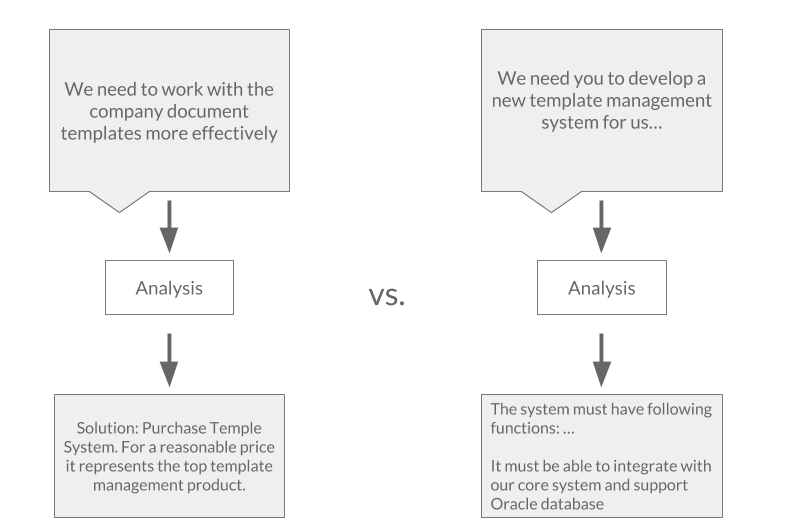Analysis in Context
Doing analysis could be described as trying to understand a need stated by the stakeholders and searching for possible solutions to that need. Although most solutions are more or less associated with IT systems, the overall solution is typically composed of multiple components, and not all of them must be IT-related. For example, the solution may include a legacy system modification, a business process change, and creating a new version of a document.
Business need: A problem or opportunity of strategic or tactical importance to be addressed.
The need might have two forms: it could be a problem the organization is facing or some opportunity the organization would like to take advantage of. Needs may also differ by their complexity. They may represent something rather trivial such as modifying a contract template because customers have been complaining about its current form. Still, they may also define a complex problem, for example, implementing a legal requirement for deleting all customers' personal data after 5 years. Such an issue could possibly involve changes to dozens of business processes, modifying several bank systems, and may lead to a couple of subprojects.
Another aspect is the context of the need. While some needs specify high-level business problems whose solutions could but don't necessarily need to be IT-related, others may be limited to an IT context that implies meeting the need using an IT solution:

The example on the left represents a valid business need. It states why a change to an organization is required: because working with document templates is ineffective. Analyzing problems within the business context requires a wide range of skills, both business and IT. On the one hand, it is needed to have a broad view of the organization and to understand its structure, capabilities, processes, and systems. In this context, the analyst's knowledge also typically spans across various enterprise departments as they need to see the big picture, unlike business representatives who live only within the boundaries of their department. On the other hand, to effectively solve the problem with the help of technologies, the analyst must have a solid understanding of the IT systems. They need to know their capabilities and limits so that they could recommend the right solution by introducing new systems or by modifying the legacy ones.
The picture on the right is an example of the need limited to an IT context. Analysis of such need typically starts with receiving a request to change a component of the IT architecture, for example, to create a new feature or to modify an existing application. In this case, the analyst is responsible purely for analyzing the requested system. The goal is to discover what capabilities the system shall have and how it is supposed to be integrated with the other parts of the IT infrastructure. Analysts are not expected to concern themselves with impacts on the current business processes, company policies, etc. They're responsible only for the technical solution, and it is assumed that the business impacts have already been considered by somebody else.
The context is determined by the input, which triggers the initiative. If it is a high-level business need, most of the analytical work is done within the business context, involving studying the business capabilities, structure, or processes. If the input is a low-level request for creating a new software feature or modifying an existing one, then the analyst works more in the IT context, focusing on finding and designing the right technical solution.
The context also influences the possible range of solutions. While defining a need for a new system or stating an imperfection of the existing one typically leads to implementing new software, in a business context, the best solution might be to change the business process or to simplify the organizational structure. The business context is about finding the best solution to solve the business need, and solving problems with the software is just one of the alternatives. For example, informing clients who have recently become VIP, could be solved by manually finding them in the system and calling them via phone, or a sophisticated report feeding an automatically created campaign could be implemented.


